Combat work MAGON
During the Great Patriotic War, all civil work aviation was subordinate to the interests of the front. For this purpose, special military units were created from Aeroflot divisions under the command of experienced commanders, civilian air flight crews fleet. Among the first to receive baptism of fire was the Moscow Airborne Special Purpose Group (MAGON) of the Civil Air Fleet, which already on June 23, 1941 began to carry out special tasks of the Red Army command. At the end of 1942, MAGON was reorganized into the 1st Air Navigation Division of the Civil Air Fleet. And on November 5, 1944, it was transformed into the 10th Guards Air Transport Division of the Civil Air Fleet. In this article, we give only a brief chronicle of the fighting of the famous aviation unit.
TO PROTECT MOSCOW
In the first half of October 1941 tank a group of German troops broke through the defense of the Western Front and approached the city of Oryol, developing an attack on Moscow from the south. To eliminate the threat of the capital, the Headquarters obliged the MAGON GVF to transfer troops of the 5th airborne corps to the aerodromes of the cities of Orel and Mtsensk. The troop transfer was carried out by a squadron consisting of seven detachments led by commander F. Gvozdev. The crews of the ship commanders P. Rybin, S. Frolovsky, A. Kalina, D. Kuznetsov, A. Voskanov, A. Lebedev, A. Sukhanov, I. Shashin, F. Kovalev and others took an active part in this operation. Crews made several sorties a day, usually at low altitudes, and in most cases without fighter cover. Pilots took on board Li-2 thirty people instead of those laid down according to instructions 25, and on the G-2 sometimes 35 instead of 18. In the defeat of the Nazis near Moscow, a significant role was played by the airborne troops, who had special training for conducting combat operations behind enemy lines . Almost all landing operations were carried out with the active participation of the air fleet.
This was in January 1942. In the Kaluga region, 28 Li-2 aircraft were urgently assembled, the crews were headed by such famous pilots of the Civil Air Fleet as N. Shebanov, A. Levchenko, A. Kulikov, V. Efimov, G. Taran, G. Benkunsky and others. They faced a combat mission - to throw a large airborne assault force in the German rear, south-west of Vyazma. The first flight with a strike group was to be performed by the formation. The leading of this group was appointed A. Semenkov. The co-pilot of the flagship crew was P. Rusakov, navigator A. Semenov. Responsibility was great. The slightest inaccuracy or error leading - the failure of a combat mission.
It was decided to follow the ranks of the "wedge" three nines. Left bearing was conducted by A. Dobrovolsky, right - by A. Kulikov. The first nine flew at a height of 20-30 meters above the ground, the second and third - with a slight excess over the first. And only when approaching the goal, Li-2 should have quickly gained altitude and dropped the paratroopers from 600 meters.
During the flight over the front line, several enemy firing points opened up fierce fire on the aircraft. But the turret arrows of our planes suppressed the German firing points. In addition, the side-gunners fired at a large column of enemy infantry moving along the route of our route. About a thousand paratroopers were delivered exactly to the designated place.
During the defensive battles near Moscow, in the period October-December 1941 of the year, pilots of the composition of the GAV GAGF made more than three thousand sorties, including more than five hundred in the German rear. Twelve thousand soldiers and officers and almost 935 tons of ammunition and other cargo were transported.
BATTLES FOR LENINGRAD
Autumn of the first military year. The fascist troops took Leningrad into the ring. By October, the only way in which food and ammunition could be delivered to the city was Ladoga. However, the frequent storms and the incessant raids of German aircraft caused disruptions of the sailors' heroic work. On October 4, the State Defense Committee obliged Aeroflot to prepare a group of transport aircraft to provide the supply of besieged Leningrad with the necessary food and ammunition. It was also necessary to take ten thousand skilled defense factory workers out of the city, bring vital goods to Leningrad every day and evacuate the wounded, sick, women and children from the city. These flights were to be performed by the most experienced and competent subunit commanders V. Pushinsky, K. Bukharov, S. Sharykin. The crews were headed by A. Dobrovolsky, G. Benkunsky, A. Kapitsa, A. Lebedev, M. Skrylnikov, F. Ilchenko, P. Kolesnikov, 8. Bulatnikov, I. Eremenko, N. Chervyakov, A. Semenkov.
Loaded "to the eyeballs" with food, transport aircraft carried out several flights a day to the besieged Leningrad. It is worth noting that on the highway, and especially above Ladoga, German fighters constantly patrolled. Once, when returning from Leningrad, six Messerschmitts attacked a group of transport aircraft. The planes of the commanders of the ships K. Mikhailov and L. Ovsyannikov were set on fire in the air. But, despite the severe injury, Leonid Ovsyannikov reached the burning car to the shore and managed to land it. Risking their lives, the crew rescued the 38 women and children that had been exported from Leningrad. Konstantin Mikhailov also landed on its shore.
The flights of civil aviation vehicles to the blockade city did not cease during the entire period of the city’s selfless defense. For the whole of 1942 and the first half of 1943 of the year, 2457 sorties were flown to our northern capital, including 146 night flights. 68 aviators were awarded orders and 290 - the medal "For the Defense of Leningrad."
OVER THE VOLGA HARD
In December 1942, the MAGON was transformed into the 1-th GVF transport aviation division. This event occurred during the active participation of crews in the battle of Stalingrad. The crews of the division delivered the necessary cargo to the front line and to the place where it was impossible to bring them by other means of transport, provided military units engaged in battles on the Volga, connected with Moscow, took out the wounded. The crews of the 1 transport aircraft division of the CAF together with the airmen of the 6 and 7 of the individual air regiments, the CAF carried out 46040 combat missions, transported about 31 thousands of soldiers and officers, took more than three thousand wounded to the rear, delivered more than 2500 warriors Dozens of aviators were awarded government awards.
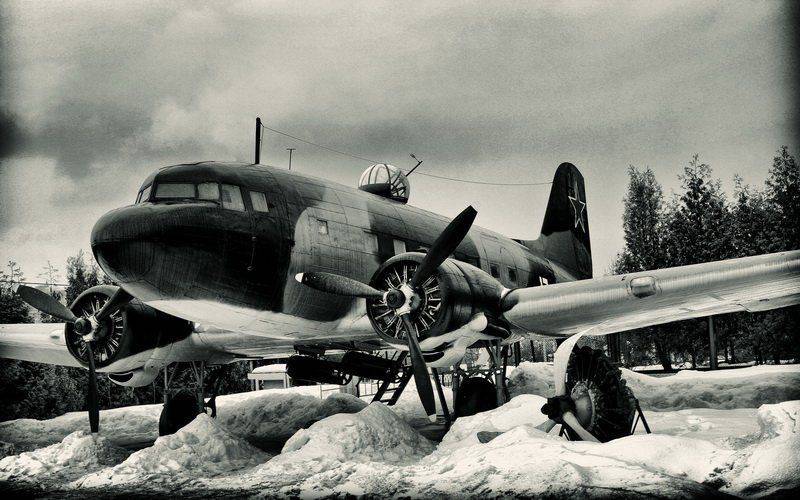
In one of his articles, Marshal of Aviation S. Rudenko, who commanded 16-WA in those years, highly appreciated the actions of the combat units of civil aviation, wrote that the heroism of civilian crews in the Battle of Stalingrad was truly massive. Any tasks assigned to them, no matter how complex and responsible they were, the pilots performed promptly, selflessly and courageously.
DEFENSE OF SEVASTOPOL
In the summer of 1942, on the eighth month of the siege of Sevastopol, the German command began the third, decisive, assault on the city. Cut off from land communications, lacking ammunition and food, our infantrymen and sailors with unprecedented heroism defended the base of the Black Sea Fleet. To help the Sevastopol garrison it was necessary to urgently organize a massive transfer of ammunition and food. The implementation of this important operation was entrusted by the Supreme Command to MAGON. The command of the air group allocated twenty of the most experienced crews of the Li-2. Among them are A. Bystritsky, V. Gulyaev, P. Kashuba and others. The combat work was carried out from the airfields of Krasnodar and the village of Korenovskaya. Landing was possible only on a small platform "Chersonesus lighthouse", which was under constant shelling.
Crews worked with great tension. For ten days (from 21 June 1942 of the year) 230 night flights were carried out with a landing in Sevastopol, more than two thousand wounded soldiers and officers were taken out. 30 June 1942 of the year on board the aircraft flying from the “Chersonesus Lighthouse” airfield (ship commander M. Skrylnikov) flew the Vice-Admiral Oktyabrsky, the commander of the Black Sea Fleet, who until the last day led the defense of the city. By the order of the North Caucasian Front Commander from 21.07.42, No. 0551, the combat work of the air group was recognized as excellent and the personnel of the air group were thanked.
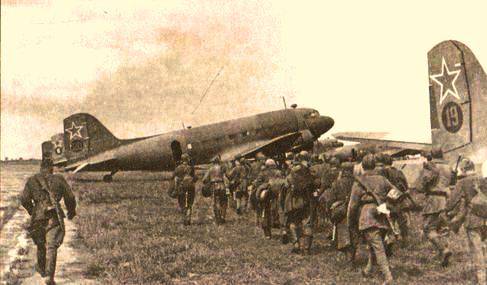
PARTISAN WAR
The selfless struggle of the partisan formations of Belarus and Ukraine, the Smolensk region, the Bryansk region, the Orlov region, is directly related to the invaluable assistance provided to the flight personnel of the division. So, to the partisans to Ukraine, 655 sorties were flown, to Belarus - 516, to the partisans of the Crimea - 435, to Moldova - 50 sorties. In addition to individual flights, the division's aircraft carried out mass operations in the German rear. So, from mid-August 1943, the division began the combat mission of transporting three partisan units consisting of 250 people and 26 tons of ammunition to the enemy’s rear to disrupt the activities of the two railways that fed the Kharkov fortified enemy site. The task was completed in seven days.
Head of the Crimean headquarters of the partisan movement Bulatov praised the activities of the division: “As a result of the heroic work of the flight personnel, the partisans of the Crimea conducted successful operations, causing great damage to the enemy both in manpower and equipment. During the military operations carried out by the partisans, in the forest partisan camps, a large number of wounded gathered in need of urgent medical care and hampering the combat activity and maneuverability of the partisan detachments. Without stopping the work on the delivery of ammunition to the partisans, the flight personnel completed the task of transporting the wounded perfectly. The squadron commanders Taran and Kashuba, the commanders of the ships Yezersky, Aliyev, Danilenko, Ilchenko, Rusanov, Bystritsky, Barilov and others, taking two flights a night and performing landing on the mountain unsuitable platforms, took more than 700 wounded. These tasks could be performed by pilots with great flying skill and courage, ready for self-sacrifice in the name of Rodima ... "For these flights, the pilots Gruzdev, Yeromasov, Kashuba, Frolovsky, Ryshkov, Taran, Radugin were awarded the title Hero of the Soviet Union.
IN THE WAYS OF THE ENEMY
In the spring of 1943, the 1 of the Civil Air Fleet's aviation division, the task was set: to ensure the offensive operations of the troops of the Central Front. For this purpose, an operational group of fourteen aircraft was formed at the Telegino airfield near Yelets. The group worked in adverse weather conditions and difficult air conditions. Pilots Mosolov, Matveyev, Pushechkin, Nazarov, Ilyin, Bulavintsev and others for two days before the scheduled date completed the task. Their work was highly appreciated by the Commander of the Central Front. In order from 05.04.43g. No. 38 on the Central Front noted that in the shortest possible time 1280 had been flown, 2 had been flown thousands of tons of ammunition, a tactical reserve had been delivered to the threatened area in the number of 13600 people, the injured had been taken to the rear.
From February 23 to March 15, 1943, the task force carried out the task of the 4-VA to transport fuel, ammunition and technical equipment to the front line. Done 370 combat missions. The transported parts provided for the restoration of 411 combat aircraft. The order from 20.04.43 on the North Caucasus Front noted that on extremely difficult days, when the ground forces and personnel of the leading airfields were in need of food and ammunition due to impassability, it was impossible to bring cars. All the burden and responsibility for the delivery of parts of the army and navy of food, ammunition, fuel were assigned to transport crews. The aviation group has completely coped with the task.
FORCING DNEPRA
From September to October 1943, the division carried out the order of the Supreme Command for assisting the Soviet troops in crossing the Dnieper. A group of aircraft under the command of B. Labutin, performing the task of the 4 of the Ukrainian Front, assisted the units of the 5 Shock Army leading to the crossing of the Dnieper near the city of Nikopol. In September, the division’s crews conducted a large-scale operation to drop an enemy rear in the Kanev region of the units of the 5 of the Airborne Corps. Overnight 31 was flown and 483 paratrooper and more than ten tons of ammunition were dropped.
From October 10 1943, on the instructions of the second Ukrainian front, from the Poltava airfield was carried out a massive operation to transport fuel and ammunition for tanks to the Pyatikhatka area. In the combat recall of the Commander of the 5 th IA, Colonel-General Aviation Goryunov, it was noted that the flight crew, following the order of the Supreme Commander, provided the advancing units of the second Ukrainian front with ammunition, weapons and fuel.
In October, 1943, during the forcing of the Dnieper, it became necessary to provide advanced units with weapons and ammunition. The crews of the division, performing five to seven sorties a day, completed the task and provided the opportunity for the Soviet troops to conduct successful offensive battles. During the Korsun-Shevchenko battle due to the thaw, vehicles could not give the troops the required amount of ammunition. This gap was filled by pilots, providing advanced units in sufficient quantities of ammunition and fuel.
FOR NIKOLAEV AND KHERSON
From February to the end of May 1944, the airplanes of the regiment commanded by K. Bukharov ensured the offensive of the forces of the Third Ukrainian Front in the direction of Kherson, Nikolaev and Odessa. In early March, the Soviet troops crossed the Ingulets River and captured the bridgehead on the west bank. Marines caught on a small piece of land, which pressed a sharp wedge into the enemy defenses. To assist the units, leading the fighting on the right bank, the command sent the aircraft of the division of the Civil Air Fleet. Under fierce enemy fire, despite the adverse weather conditions, the pilots headed to the area of the breakthrough.
Crews of the commanders of the ships Poteev, Okinin, Bykov, Vasilyev and Tyupkin dropped a large amount of fuel to our tank formations, which extended the breakthrough. It was made 1225 sorties. The group also interacted with General Pliev's tank and cavalry units, which had gone into deep raids in the rear of the enemy. The Deputy Commander of the Third Ukrainian Front assessed the combat work in the breakthrough area as follows: “The transport group 1 - and ATD, with their efficiency and maneuverability in combat, contributed to the successful deepening of the bridgehead on the Ingulets River. The crews were faced with a new task - to provide the units that had broken into operational space in the German rear, with fuel and ammunition. The group coped well with the task. By order of Stakes, the First Air Transport Regiment received the honorary title “Kherson”.
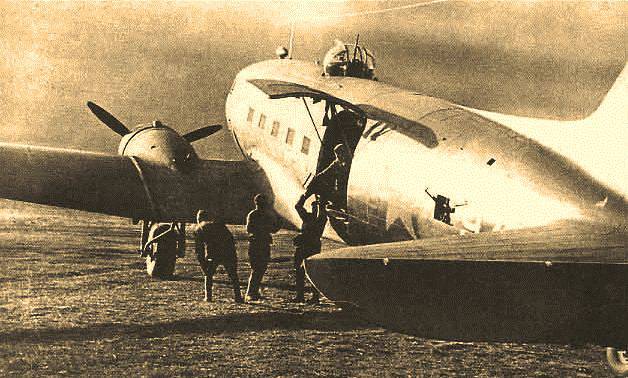
FOR BELARUS AND BALTIC
12 June 1944 of the Year The headquarters of the Supreme Commander ordered to send aircraft to the Third Ukrainian Front to support the actions of the troops advancing on the Minsk-Vilnius direction. Fulfilling the order, the division command sent two groups of 26 aircraft under the command of Polosukhin and Ivanov, under the general supervision of regiment commander G. Taran. The next day, the crews of the regiment (the commanders of the ships Bugrenko, Heart, Zadorozhny, Shevyakov, Kuzmin, Pechkorin, Kirsanov, Slepov, Ilyin, Zakharov. Mosquitoes, Potapov, Bautin and others), began to redeploy the 1-VA to advanced airfields and uninterrupted supply of ammunition and fuel. Within ten days, three fighter and one bomber corps and an assault division were deployed. Excellent operational work made it possible for the Soviet attack aircraft and bomber to deliver a powerful blow to the fortifications and manpower of the fascists.
23 June 1944, our troops came close to the railway Vitebsk - Orsha. The command gave the order to find General Obukhov’s tank corps that had broken through to the German rear and organize the delivery of fuel to the stopped tanks. The solution of this problem practically solved the fate of the operation of Obukhov. Fuel and ammunition were delivered in a timely manner, and the tanks rushed forward. The rate of advance was growing, each crew had to be airborne every day for up to twelve hours or more. During the battles on the approaches to Vilnius, the pilots of the third regiment were able to transport tons of combat cargoes to the 216 front grounds in one day. By order of the Supreme Commander No. 0213, the Third Regiment was given the title of "Vilnius".
LIBERATION OF YUGOSLAVIA
The group under the command of P. Eromasov far from the homeland fulfilled the important and difficult task of supplying the partisan detachments of Albania, Greece and Yugoslavia weapons, ammunition, medicine, evacuating the wounded and performing other special tasks. The air group worked in extremely difficult conditions: flights had to be made through the Adriatic Sea and in the highlands at night. Landing grounds were organized by partisans on the mountain slopes and in the valleys of mountain streams. The fact that the crews of British and American aircraft stationed on the same airfield with the Soviet group refused to fly to the sites where our pilots landed speaks about the skill and determination of our pilots.
In less than a year, a group of ten crews made 972 combat sorties, including 387 - with landing in enemy rear. On our aircraft 1603 wounded were taken, and five thousand soldiers and commanders were transferred to partisan detachments, more than 1000 tons of ammunition and other important cargoes. November 7 1944 of the Year, “for endurance, discipline and organization, for heroism” The first air transport division of the Civil Air Fleet was transformed into the 10-th Guards Air Transport Division.
At the end of the war, the 10 Guards Division was assigned the task of delivering high-power special ammunition from Gorky to the assault on Berlin. On April 21, a group of commander Major V. Chernyakova completed the mission, and the gunners received a full load of special ammunition. The flight of the crew of the commander of the Second Sevastopol regiment, A. I. Semenkov, on May 9 on May 1945, which delivered the act of unconditional surrender from Berlin to Moscow, became the final point of the combat operations of the air transport division.
In conclusion, we will call a few figures: the personnel of the 10 th Guards Air Transport Division made sorties to the enemy rear - 7227; taken from the rear of the enemy - 9105 people; delivered to the rear of the enemy -28695 people, various cargo - 7867 tons; made flights to the front - 52417; transported to the front -298189 man, various loads - 365410 tons. Fourteen pilots were awarded the title Hero of the Soviet Union, awarded the Order of Lenin - eight people, the Order of the Red Banner - 185 people, the Order of the Patriotic War - 221 people, the Order of the Red Star - 600, the medal "For Courage" - 267, the Medal "For Military Merit" - 354 person. 30 November 1946, the 10-I Guards Division was disbanded and ceased to exist as a military unit. But the pilots continued to fly. From the ranks of the division in Moscow, the first air group and international air service air group were created. Dozens of pilots, navigators, flight mechanics, radio operators, engineers and technicians were sent to all the departments of the Civil Air Fleet. In fact, the personnel of the division became almost the backbone of peaceful transport aviation in the post-war years.
Sources:
Strelbitsky K. MAGON activity on supplying besieged Sevastopol // Military Crimea. No.7. 2007. C. 37-42.
Krasnoyarov V., Yalygin M. Air bridge over Ladoga. L .: Lenizdat, 1984. C. 2-4, 122-143.
Okinin N., Popova A. Under the Guards Banner // Civil Aviation. 1988. No.5. C. 15-19.
Filatov I., Dragovoz P. Peaceful wings during the war. M .: Air transport, 1995. C. 43-56, 103-117.
Filatov I. Civil air fleet in the Great Patriotic War 1941 — 1945. M .: Air transport, 1995. C. 7-14, 84-97.
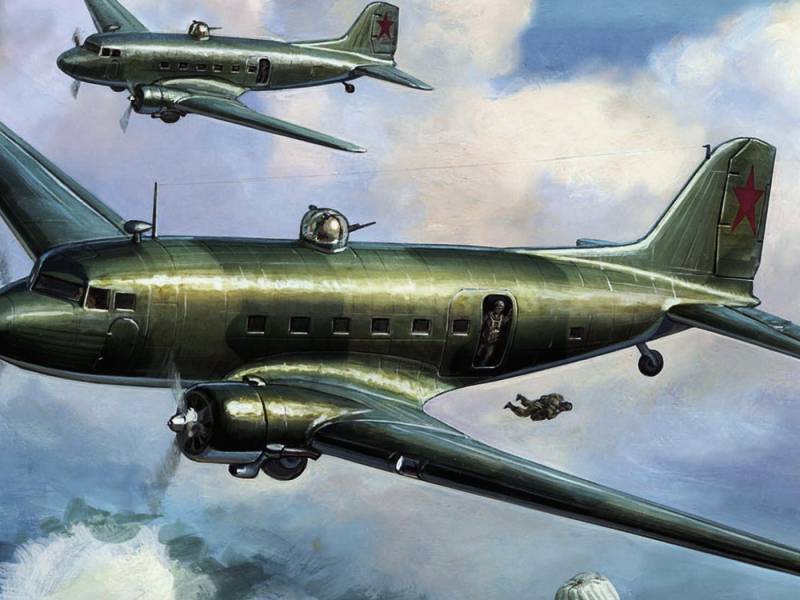
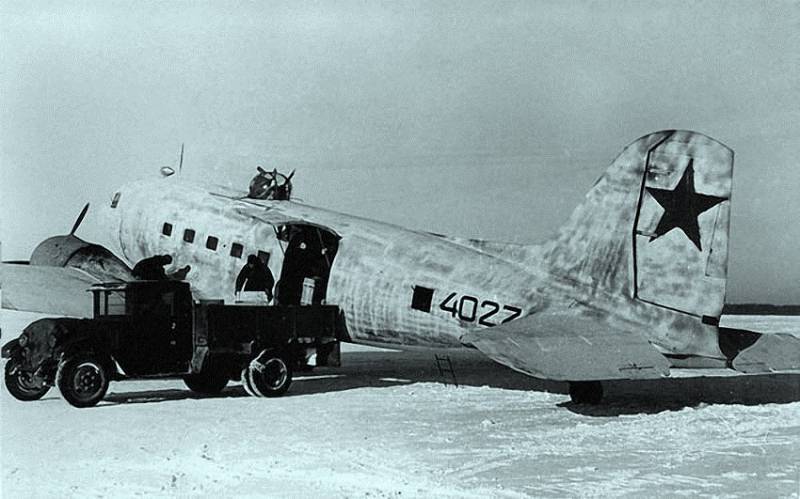
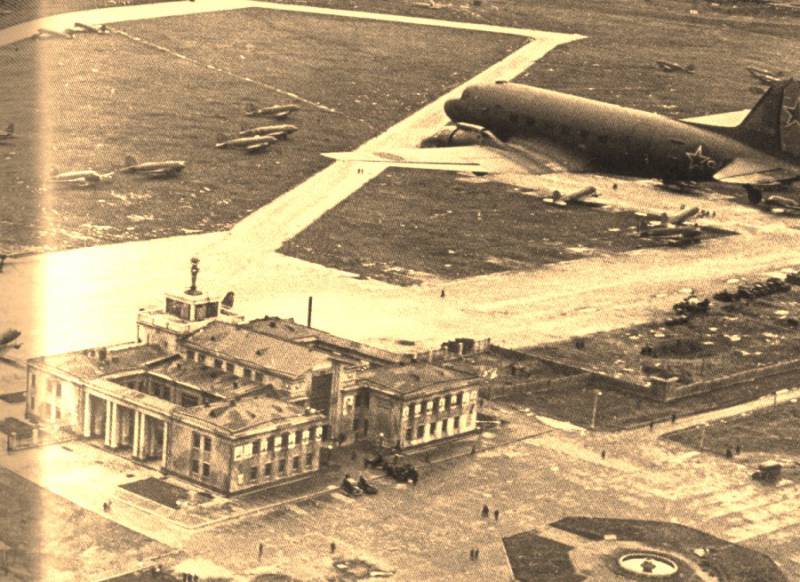
Information